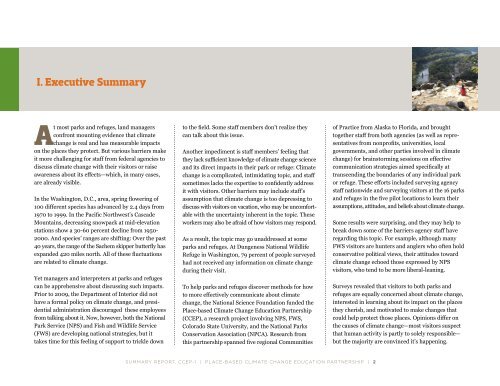Place-based Climate Change Education Partnership Report.pdf
Place-based Climate Change Education Partnership Report.pdf
Place-based Climate Change Education Partnership Report.pdf
You also want an ePaper? Increase the reach of your titles
YUMPU automatically turns print PDFs into web optimized ePapers that Google loves.
I. Executive Summary<br />
At most parks and refuges, land managers<br />
confront mounting evidence that climate<br />
change is real and has measurable impacts<br />
on the places they protect. But various barriers make<br />
it more challenging for staff from federal agencies to<br />
discuss climate change with their visitors or raise<br />
awareness about its effects—which, in many cases,<br />
are already visible.<br />
In the Washington, D.C., area, spring flowering of<br />
100 different species has advanced by 2.4 days from<br />
1970 to 1999. In the Pacific Northwest’s Cascade<br />
Mountains, decreasing snowpack at mid-elevation<br />
stations show a 30-60 percent decline from 1950-<br />
2000. And species’ ranges are shifting: Over the past<br />
40 years, the range of the Sachem skipper butterfly has<br />
expanded 420 miles north. All of these fluctuations<br />
are related to climate change.<br />
Yet managers and interpreters at parks and refuges<br />
can be apprehensive about discussing such impacts.<br />
Prior to 2009, the Department of Interior did not<br />
have a formal policy on climate change, and presidential<br />
administration discouraged these employees<br />
from talking about it. Now, however, both the National<br />
Park Service (NPS) and Fish and Wildlife Service<br />
(FWS) are developing national strategies, but it<br />
takes time for this feeling of support to trickle down<br />
to the field. Some staff members don’t realize they<br />
can talk about this issue.<br />
Another impediment is staff members’ feeling that<br />
they lack sufficient knowledge of climate change science<br />
and its direct impacts in their park or refuge: <strong>Climate</strong><br />
change is a complicated, intimidating topic, and staff<br />
sometimes lacks the expertise to confidently address<br />
it with visitors. Other barriers may include staff’s<br />
assumption that climate change is too depressing to<br />
discuss with visitors on vacation, who may be uncomfortable<br />
with the uncertainty inherent in the topic. These<br />
workers may also be afraid of how visitors may respond.<br />
As a result, the topic may go unaddressed at some<br />
parks and refuges. At Dungeness National Wildlife<br />
Refuge in Washington, 79 percent of people surveyed<br />
had not received any information on climate change<br />
during their visit.<br />
To help parks and refuges discover methods for how<br />
to more effectively communicate about climate<br />
change, the National Science Foundation funded the<br />
<strong>Place</strong>-<strong>based</strong> <strong>Climate</strong> <strong>Change</strong> <strong>Education</strong> <strong>Partnership</strong><br />
(CCEP), a research project involving NPS, FWS,<br />
Colorado State University, and the National Parks<br />
Conservation Association (NPCA). Research from<br />
this partnership spanned five regional Communities<br />
of Practice from Alaska to Florida, and brought<br />
together staff from both agencies (as well as representatives<br />
from nonprofits, universities, local<br />
governments, and other parties involved in climate<br />
change) for brainstorming sessions on effective<br />
communication strategies aimed specifically at<br />
transcending the boundaries of any individual park<br />
or refuge. These efforts included surveying agency<br />
staff nationwide and surveying visitors at the 16 parks<br />
and refuges in the five pilot locations to learn their<br />
assumptions, attitudes, and beliefs about climate change.<br />
Some results were surprising, and they may help to<br />
break down some of the barriers agency staff have<br />
regarding this topic. For example, although many<br />
FWS visitors are hunters and anglers who often hold<br />
conservative political views, their attitudes toward<br />
climate change echoed those expressed by NPS<br />
visitors, who tend to be more liberal-leaning.<br />
Surveys revealed that visitors to both parks and<br />
refuges are equally concerned about climate change,<br />
interested in learning about its impact on the places<br />
they cherish, and motivated to make changes that<br />
could help protect those places. Opinions differ on<br />
the causes of climate change—most visitors suspect<br />
that human activity is partly to solely responsible—<br />
but the majority are convinced it’s happening.











